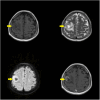Solitary brain metastasis from laryngeal squamous cell carcinoma in a 68-year-old male: A Case Report
- PMID: 40787541
- PMCID: PMC12333697
- DOI: 10.1097/MS9.0000000000003549
Solitary brain metastasis from laryngeal squamous cell carcinoma in a 68-year-old male: A Case Report
Abstract
Introduction and importance: Laryngeal squamous cell carcinoma (LSCC) commonly metastasizes to regional lymph nodes, lungs, liver, and bones. Intracranial metastasis from LSCC is exceedingly rare, reported in only 0.4% of cases. The atypical presentation can delay diagnosis and negatively impact prognosis. We report a rare case of solitary brain metastasis from LSCC, highlighting the diagnostic challenges and clinical considerations.
Case presentation: A 68-year-old Pakistani male with a prior diagnosis of LSCC presented with new-onset generalized tonic-clonic seizures. He had previously undergone total laryngectomy, radiotherapy, and chemotherapy. Brain MRI revealed a right frontal lobe lesion with surrounding edema, consistent with a solitary metastasis. Histopathology following craniotomy confirmed metastatic squamous cell carcinoma. The patient was managed with antiepileptics and referred for palliative whole-brain radiotherapy. He and his family opted for palliative care, declining further aggressive treatment.
Clinical discussion: Distant brain metastasis in LSCC is rare and may occur without prior systemic spread. The mechanism may involve perineural invasion, although the exact pathophysiology remains unclear. Current diagnostic approaches include MRI and FDG-PET/CT. Due to limited cases, standardized treatment protocols are lacking. Management options include surgery, radiotherapy, chemotherapy, and palliative care, depending on disease progression and patient preference. Seizures as a presenting symptom are uncommon but may indicate intracranial involvement.
Conclusion: This case emphasizes the need for high clinical suspicion and comprehensive neurological assessment in patients with advanced LSCC. Early diagnosis and multidisciplinary management are essential for improving outcomes in this rare but serious manifestation.
Copyright © 2025 The Author(s). Published by Wolters Kluwer Health, Inc.
Conflict of interest statement
Sponsorships or competing interests that may be relevant to content are disclosed at the end of this article. The authors declare no potential conflicts of interest with respect to the research, authorship, and/or publication of this article.
Figures



Similar articles
-
Idiopathic (Genetic) Generalized Epilepsy.2024 Feb 12. In: StatPearls [Internet]. Treasure Island (FL): StatPearls Publishing; 2025 Jan–. 2024 Feb 12. In: StatPearls [Internet]. Treasure Island (FL): StatPearls Publishing; 2025 Jan–. PMID: 31536218 Free Books & Documents.
-
A rapid and systematic review of the clinical effectiveness and cost-effectiveness of paclitaxel, docetaxel, gemcitabine and vinorelbine in non-small-cell lung cancer.Health Technol Assess. 2001;5(32):1-195. doi: 10.3310/hta5320. Health Technol Assess. 2001. PMID: 12065068
-
123I-MIBG scintigraphy and 18F-FDG-PET imaging for diagnosing neuroblastoma.Cochrane Database Syst Rev. 2015 Sep 29;2015(9):CD009263. doi: 10.1002/14651858.CD009263.pub2. Cochrane Database Syst Rev. 2015. PMID: 26417712 Free PMC article.
-
Systemic treatments for metastatic cutaneous melanoma.Cochrane Database Syst Rev. 2018 Feb 6;2(2):CD011123. doi: 10.1002/14651858.CD011123.pub2. Cochrane Database Syst Rev. 2018. PMID: 29405038 Free PMC article.
-
The recurrence and multi-organ involvement of giant penile plexiform neurofibroma in an adult with neurofibromatosis type 1: a case report.BMC Urol. 2025 Jul 21;25(1):180. doi: 10.1186/s12894-025-01881-w. BMC Urol. 2025. PMID: 40691787 Free PMC article.
References
Publication types
LinkOut - more resources
Full Text Sources
